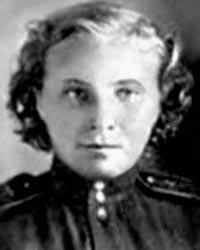
Lidiya Vladimirovna Litviak (1921-1943)
Lidiia Vladimirovna Litviak was born August 18, 1921 in Moscow. (d. August 1, 1943) Tragedy struck her, like so many in Russia during the purge. In 1937 her father was arrested as "an enemy of the people" and later executed. This meant that she had to conceal her family background and throughout her life carried a terrible secret. If the truth came out, it would mean banishment from flying, from any other productive activity, or worse.
Naming problems (Ed. 8/02)When the war began, the many women pilots across Russia offered their services. Initially they were rebuffed, but in the wake of early military disasters, Marina Raskova, the famous Russian woman aviator, was able to persuade Stalin to allow her to organize three regiments of women flyers. Lidiia was one of the women accepted and began military training at Engels on October 15, 1941. ...more
Lidya Vladimirovna Litvak Lidya Vladimirovna Litvak - born August 18, 1921 - a World War II Soviet ace with 12 confirmed kills of German planes. Lidya Litvak loved to do aerobatics and her flamboyant maneuver of swooping over the hangars, soaring up into a victory roll, then a tight turn and a perfect landing would signify to onlookers that she had made a combat "kill." On her first official sortie on the front she was the primary destroyer of a Heinkel bomber. Her own Yak plane was hit by bullets from a German plane. By the end of that year she had shot down six German planes by herself. Her flamboyant personality extended to putting herself in greater danger by marking her plane with paintings of large White Roses which enabled the enemy to spot her coming. Legend has it that German pilots would exchange warnings when they spotted her distinctive markings. Each year, it seems, more legends are built around Litvak including her femininity. One has to wonder why it is so necessary for historians to do that. Her life was involved in the day-by-day reality of kill or be killed and much of it in the bitter Russian winter during the defense of motherland. ...more
Lilya Litvyak - the White Rose of Stalingrad When war in the Soviet Union broke out in 1941 Lilya Litvyak was serving as a flight instructor, having secretly begun to learn to fly with the local air club at the young age of 14. Training 45 students before the war began, Litvyak applied repeatedly for military duty when the war started and at the last minute she heard about a women's group being formed by Marina Roskova. Litvyak went for an interview and was accepted. In training Lilya outshone her male trainers and scored above the other trainees. During a practice dogfight in her slow 100 M.P.H. PO - 2 trainer Lilya shot down her instructor. Heading back to base Lilya performed a flamboyant manoeuvre that was later to become her trademark. Swooping low over the hangers, she soared up into a victory roll, then landed. Upon completion of her advanced training Lilya, along with the other trainees formed the 586th (all woman) Fighter Regiment flying the Yakovlev Yak-1. ...more
The Soviet Air Force in World War II At first, the Soviet Union found itself out of the war, shielded by a non-aggression pact made between Hitler and Stalin, and then in the thick of it when Germany opted to ignore the agreement and attack Russia, on June 22, 1941. (The Soviet Union did not declare war on Japan until six days before Japan surrendered.) The role of air power in Russia was difficult to determine: the areas involved were too vast to permit either side to claim air superiority, and the weather often made the entire issue moot, as the war was sometimes fought strictly on the ground and by artillery. Aviation had developed in Russia along active and parallel lines to its development in Europe and in America. The father of Russian aviation, Nikolai Zhukovsky, had established a wind tunnel research station in Moscow in 1914, beginning a deep tradition of aeronautical research in Russia. The designer who became the most prolific in the years fol lowing World War I was Andrei Nikolaevich Tupolev. It was in a Tupolev plane, the ANT-25, that three Russian fliers made their 1937 nonstop flight from Moscow to California over the North Pole, a flight of 6,750 miles (10,861km) completed in sixty-two hours and seventeen minutes. ...more
|
© Copyright 1999-2002 CTIE - All Rights Reserved - Caution |
 Lidiia Litviak
Lidiia Litviak